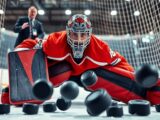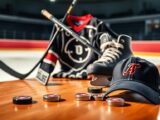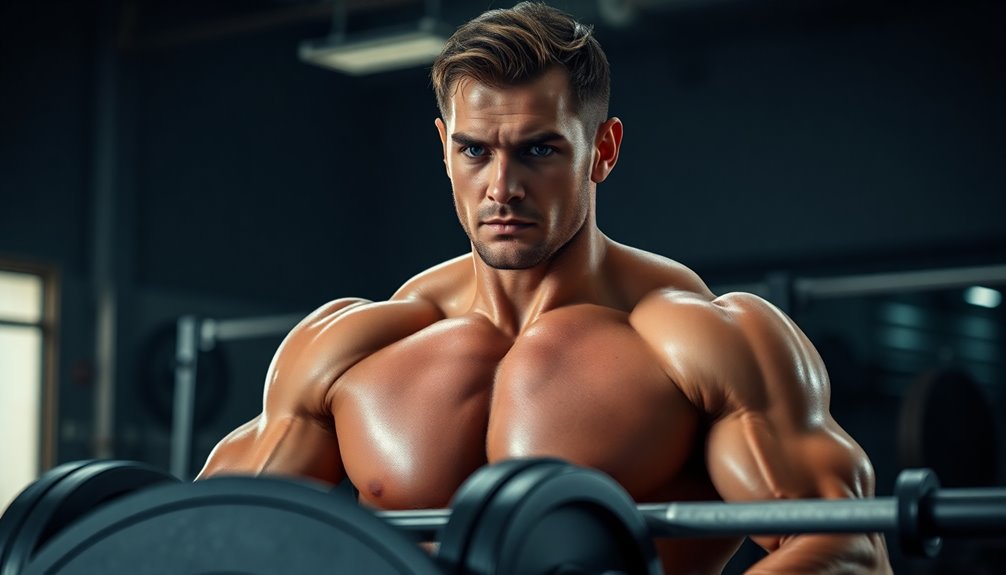
Achieving the Ideal Hockey Player Body Through Training
December 22, 2024To achieve the ideal hockey player body, you need a well-structured training plan that combines off-ice workouts, strength development, and nutrition. Focus on key movement patterns like squats and deadlifts while lifting heavy to build power. Incorporate agility drills to improve speed and explosiveness. A balanced diet with plenty of whole foods keeps your energy levels up and aids recovery. Don't underestimate the importance of rest—adequate sleep and active recovery boost performance. Finally, avoid common training mistakes to guarantee you're making progress. Keep going, and you'll discover more strategies to elevate your game even further.
Off-Ice Training Essentials
Off-ice training is a significant aspect of a hockey player's development that can't be overlooked. It plays an important role in building strength and conditioning, which directly influences your on-ice performance. By engaging in structured off-ice training programs, you can enhance your adaptability to the game's evolving demands.
Focusing on five key movement patterns—Lunge, Hinge, Squat, Push, and Pull—ensures your workouts promote functional athleticism instead of isolating muscle groups. A typical off-ice session should start with a 15-minute dynamic warm-up to prepare your body.
Next, dedicate 15-25 minutes to agility and plyometric drills to improve your speed and explosiveness, including specific drills like agility ladder drills that mimic game situations. Speed endurance drills can also be integrated to further enhance your performance. Finally, incorporate a strength/power block that features 2-3 exercises from the different movement patterns to build foundational strength. Consistent practice of these drills can lead to significant improvements in speed and agility, contributing to better on-ice performance.
Don't forget the importance of regular mobility training, as it's essential for injury prevention and enhancing athletic longevity. Stretching enhances flexibility, which is crucial for preventing injuries during intense training sessions.
By committing to off-ice training, you not only bolster your physical capabilities but also prepare yourself for the intense demands of hockey, making it an integral component of your development as a player.
Stay consistent, and you'll see the benefits translate to your on-ice performance.
Key Movement Patterns
To excel on the ice, you need to master five key movement patterns: Lunge, Hinge, Squat, Push, and Pull. These full-body movements are essential for enhancing your overall athletic performance and are important for on-ice effectiveness. Cardiovascular endurance is also crucial for sustaining energy throughout games, as it supports these movement patterns. Regular cardio workouts help maintain the stamina required for these movements during gameplay.
Unlike traditional bodybuilding, where isolating muscle groups reigns supreme, your Strength and Conditioning training should prioritize these movement patterns to meet hockey's dynamic demands.
Incorporating all five movement patterns into your off-season training helps you develop the kinetic chains necessary for powerful skating, shooting, and physical play. Each pattern plays a unique role—lunges improve your agility, hinges build posterior chain strength, squats enhance leg power, pushes increase upper body force, and pulls develop back strength and stability. Additionally, engaging in varied workouts can significantly improve your cardiovascular endurance, which is essential for maintaining a high level of performance on the ice.
Additionally, don't overlook the importance of core and mobility exercises alongside these key movements. They're crucial for maintaining balance and stability, as well as preventing injuries. Implementing a proper warm-up routine before your training sessions is vital to ensure optimal performance and reduce the risk of injury.
As you adapt your training focus based on seasonal phases and individual goals, remember that emphasizing these movement patterns will keep you on track to achieving the ideal hockey player body. Mastering them will set you apart on the ice.
Effective Workout Structure
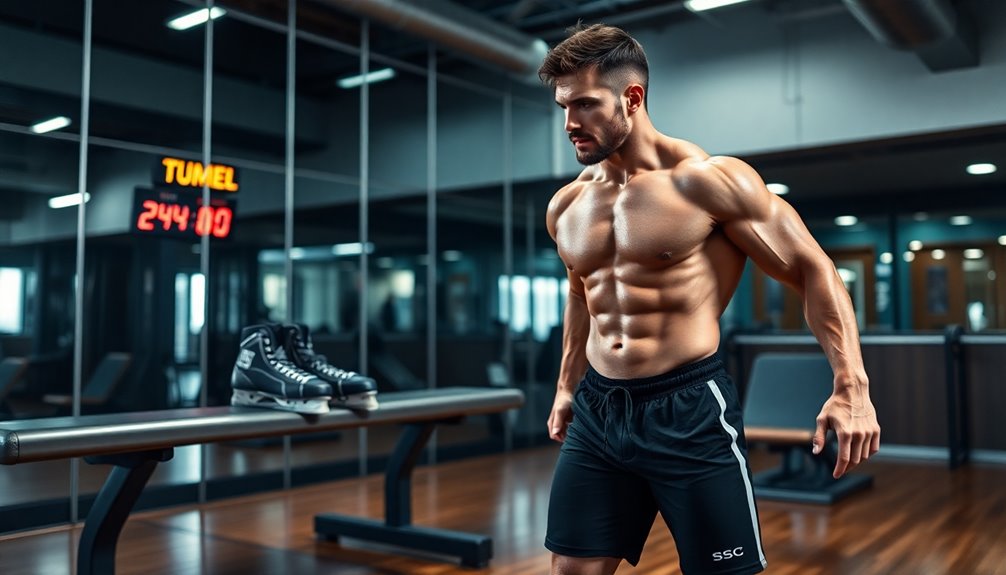
Creating an effective workout structure is crucial for maximizing your performance as a hockey player. Start with a dynamic warm-up lasting 15 minutes to prep your body for the demands of hockey training.
Follow this with 15-25 minutes focusing on athleticism, including speed, agility, and plyometric drills that enhance your quickness on the ice.
Next, plunge into the strength/power block. Your strength and conditioning coach should guide you through 2-3 exercises targeting essential movement patterns like lunges, hinges, squats, and pushes or pulls. This approach builds lower body strength and overall athleticism.
Make certain to balance push and pull exercises to prevent any muscular imbalances, which could hinder your performance.
Incorporate an additional block of 3-4 core-integrated exercises to enhance your stability and functional strength, crucial for on-ice performance. Additionally, regular assessments can help you focus on speed and agility training, which is essential for improving overall game impact and physical abilities.
Finally, don't underestimate the importance of regular assessments and adaptations to your workout program. This guarantees your training aligns with the evolving demands of the sport and your individual goals, helping you stay at the top of your game.
Strength and Power Development
Building on the foundation set by an effective workout structure, strength and power development takes center stage in your training regimen. To maximize your performance on the ice, focus on heavy lifting, aiming for personal records (PRs) in the 3-8 rep range.
Target foundational strength exercises like squats, deadlifts, chin-ups, and bench presses. For peak performance, endeavor to squat 2x your body weight and deadlift 2.5x your body weight. Incorporating principles of defensive coordination can also enhance your overall effectiveness on the ice. Additionally, effective communication among teammates can help create a supportive training environment that fosters growth.
Incorporate power-focused movements, such as Olympic lifts and plyometric exercises, to enhance your explosive athletic performance. Pain shuttles drill can also be integrated to improve your overall endurance and agility, which are crucial for hockey.
Commit to high-frequency strength training sessions, ideally 3-4 times per week during the off-season. This consistency will allow you to maximize your strength development and maintain a competitive edge.
Nutrition for Performance

Nutrition serves as the cornerstone of athletic performance for hockey players, directly influencing your strength, endurance, and recovery. To excel on the ice, focus on consuming real, healthy foods like lean meats, fish, eggs, fruits, vegetables, and starchy carbohydrates. These foods are essential for supporting muscle building and achieving ideal body composition, which is critical for performance. Additionally, incorporating speed and agility workouts can further enhance your performance on the ice. Effective conditioning, including dynamic stretches, can also help prevent injuries and improve overall athletic performance.
Excess body fat can greatly hinder your athletic capabilities. Studies show that a 20 lbs overweight hockey player can face notable disadvantages during games. It's important to maintain a healthy weight to enhance your speed and agility on the ice.
While supplements like creatine monohydrate and quality fish oil may offer benefits, they aren't necessary if your diet is balanced and rich in whole foods that provide sufficient protein.
As a young athlete, having supportive parents who promote healthy eating habits is invaluable. They can help guarantee you have access to nutritious food options that fuel your training.
A well-structured nutrition plan maximizes your strength gains and maintains energy levels, allowing you to perform at your best during practices and games. Incorporating proper nutrition strategies can elevate your overall performance and enhance your training outcomes. Prioritize your nutrition to elevate your game.
Recovery Techniques
When it comes to recovery, getting enough sleep is essential for your muscle growth and overall performance. Incorporating active recovery methods like yoga or light aerobic exercises can greatly enhance your recovery process. Additionally, engaging in dynamic warm-up routines can prepare your body for the next training session and improve overall performance. Furthermore, prioritizing adequate sleep and proper nutrition is critical for maintaining optimal energy levels and performance.
Importance of Sleep
Sleep plays an essential role in your recovery routine as a hockey player, directly influencing your performance on the ice. Adequate sleep, typically ranging from 8 to 10 hours per night, is important for muscle recovery, cognitive function, and overall athletic performance.
When you skimp on sleep, you risk decreased performance, increased injury likelihood, and impaired judgment during games.
Deep sleep is particularly important, as this is when your body releases growth hormone, necessary for muscle repair and growth. Prioritizing quality sleep can lead to improved reaction times, speed, and strength, all of which are key components of your game.
Establishing consistent sleep routines—going to bed and waking up at the same time daily—can greatly enhance your recovery and performance.
Active Recovery Methods
Active recovery methods are vital for any hockey player's training regimen, helping you bounce back faster between intense sessions. Engaging in low-intensity activities like light jogging, cycling, or swimming for 20-30 minutes post-workout maintains blood flow to your muscles, promoting muscle recovery without adding fatigue. This approach facilitates the removal of metabolic waste products, keeping your body primed for performance.
Incorporating stretching or mobility exercises during your active recovery sessions is essential. Not only does it enhance flexibility and range of motion, but it also prepares you for the dynamic movements required in hockey.
Additionally, using foam rollers or massage balls can greatly reduce muscle soreness and improve tissue quality by increasing circulation and decreasing muscle tightness.
Schedule active recovery days 1-2 times a week to prevent overtraining and enhance your overall athletic performance. Remember, these methods aren't just about resting; they're about actively supporting your body's recovery process.
Common Training Mistakes
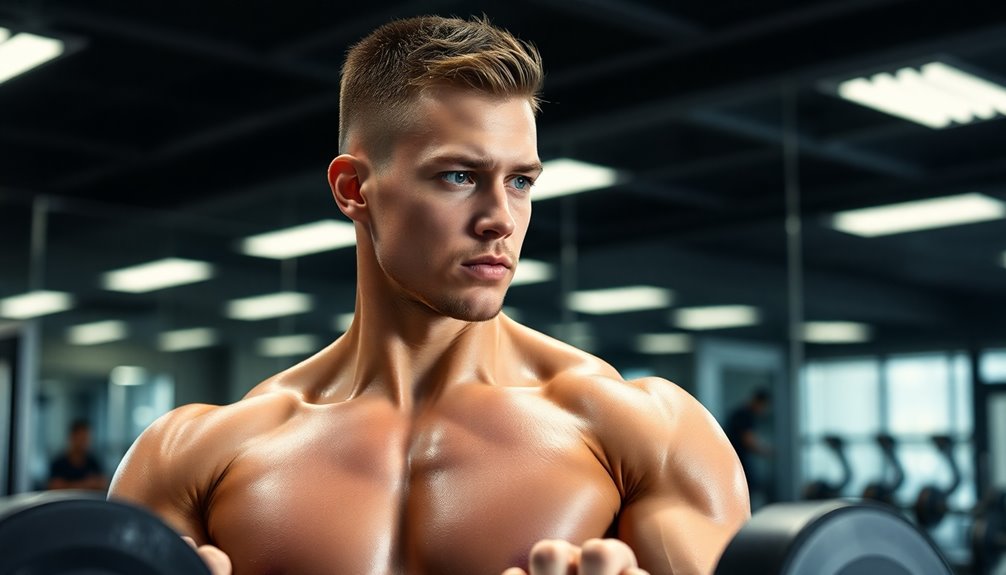
Many players stick to outdated workout routines that hold them back from reaching their full potential.
You might also find yourself lacking a structured approach, which can lead to stagnation in your progress.
Let's explore how these common mistakes can affect your training and performance on the ice.
Outdated Workout Routines
Outdated workout routines often lead to frustrating plateaus in performance for hockey players. Many individuals still rely on bodybuilder-style splits that don't translate well to the demands of the game.
You need training programs that emphasize full-body workouts and key movement patterns to enhance your athletic performance.
One common mistake is the belief that high repetitions build strength. In reality, focusing on lower reps in the 3-8 range can yield significant gains, especially during the hockey season.
Training methods that prioritize aesthetics often neglect functional strength, which is critical for on-ice performance.
Incorporating variety into your Strength and Conditioning program is essential. Sticking to the same exercises and set/rep schemes can lead to stagnation, limiting your progress.
You should also combine strength training with power-focused movements, like Olympic lifts and plyometrics, to maximize your athletic capabilities.
Lack of Structured Approach
A structured training approach is essential for hockey players aiming to improve their performance. Without it, you might experience a lack of progress and limited improvements in strength and power. Many players fall into the trap of outdated workout routines, failing to adjust their exercises, sets, and reps regularly. This stagnation can hinder your development.
You might believe that longer workouts are better, but focused training sessions lasting just 20 minutes, 2-3 times a week can yield significant gains. Additionally, it's vital to prioritize essential movement patterns over isolation exercises. Incorporating full-body workouts that emphasize key movements like squats, hinges, and pushes will enhance your overall performance on the ice.
Neglecting a structured strength and conditioning program can lead to imbalances in your training. You could end up developing endurance at the expense of the strength and power fundamental for your success in hockey.
To avoid these common pitfalls, commit to a well-rounded training plan that addresses all aspects of your athleticism. Embrace a structured approach, and you'll see substantial improvements in your on-ice performance.
Mindset for Success
Success in hockey isn't just about physical prowess; it's also about cultivating the right mindset. To truly excel, you need to develop a growth mindset, which enables you to embrace challenges and view setbacks as valuable learning experiences.
Additionally, mental resilience is essential, helping you maintain focus and motivation during tough training sessions or competitions.
Here are four strategies to enhance your mindset for success:
- Set Clear Goals: Define specific, measurable objectives that guide your training and performance.
- Visualize Success: Regularly practice mental imagery to envision yourself succeeding on the ice, boosting your confidence.
- Stay Consistent: Stick to a regular workout schedule; consistency is crucial for long-term success and ideal physical development.
- Practice Mindfulness: Engage in mindfulness techniques to improve concentration and reduce anxiety during high-pressure situations.
Conclusion
In your quest for the ideal hockey player body, remember that it's not just about the grind; it's about smart training and fueling your body right. Like a well-oiled machine, each component—strength, nutrition, recovery—works together to elevate your game. Stay mindful of common pitfalls, and cultivate a winning mindset. With dedication and the right approach, you'll transform yourself into a force on the ice, ready to skate circles around the competition. Keep pushing forward!

